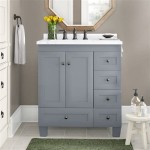Porcelain vs. Ceramic Bathroom Sinks: A Comprehensive Comparison
The selection of a bathroom sink is a crucial design decision that impacts both the aesthetics and functionality of the space. Among the numerous materials available, porcelain and ceramic are two of the most popular choices. While often used interchangeably, they possess distinct characteristics that influence their durability, appearance, maintenance requirements, and overall cost. This article provides a detailed comparison of porcelain and ceramic bathroom sinks, assisting in making an informed decision that aligns with individual needs and preferences.
Understanding the Composition and Manufacturing Processes
Porcelain and ceramic are both types of clay-based materials that are hardened through a firing process at high temperatures. However, their composition and manufacturing differ, resulting in variations in their properties.
Ceramic is a broad term encompassing a wide range of clay-based products. Ceramic bathroom sinks are typically made from earthenware or stoneware clay. Earthenware is a more porous and less durable type of clay fired at lower temperatures. Stoneware is denser and stronger, requiring higher firing temperatures. The surface of a ceramic sink is usually covered with a glaze to provide a smooth, non-porous finish and enhance its appearance.
Porcelain is a specific type of ceramic made from a finer clay mixture, including kaolin, feldspar, and silica. It is fired at significantly higher temperatures than most ceramics, resulting in a denser, less porous, and more durable material. Porcelain is often referred to as vitreous china, especially in the context of bathroom fixtures. The high firing temperature vitrifies the clay, making it glass-like and significantly reducing its water absorption rate.
The manufacturing process for both porcelain and ceramic sinks involves shaping the clay mixture, often using molds. After the initial shaping, the sink is dried before being fired in a kiln. This firing process hardens the clay and transforms it into a rigid structure. Glazing is applied after the initial firing, and the sink is then fired again to fuse the glaze to the surface.
Durability and Resistance to Damage
The durability of a bathroom sink is a critical factor, considering its frequent use and exposure to water, cleaning agents, and potential impacts. The differing compositions and manufacturing processes of porcelain and ceramic result in variations in their resistance to damage.
Porcelain, due to its denser structure and lower porosity, generally exhibits greater resistance to scratches, chips, and stains than ceramic. The vitrified surface of porcelain is less susceptible to absorbing liquids and chemicals, making it more resistant to staining from cosmetics, hair dyes, and other common bathroom products. The high firing temperature also contributes to its enhanced strength, reducing the likelihood of cracking or chipping from accidental impacts.
Ceramic sinks, particularly those made from earthenware, are more prone to scratching and chipping due to their softer composition. While the glaze provides a protective layer, it can be scratched or worn away over time, exposing the underlying clay. Ceramic sinks are also more susceptible to staining, especially if the glaze is damaged or porous. However, stoneware ceramic sinks offer improved durability compared to earthenware, approaching the robustness of porcelain.
The impact resistance of both porcelain and ceramic sinks depends on the thickness of the material and the design of the sink. Thicker sinks, regardless of the material, are generally more resistant to cracking. Undermount sinks, which are supported by the countertop, may be less prone to damage than vessel sinks, which sit on top of the countertop and are more exposed to impacts.
Aesthetic Considerations and Design Options
The aesthetic appeal of a bathroom sink is crucial for complementing the overall design of the bathroom. Both porcelain and ceramic offer a wide range of design options in terms of shapes, sizes, colors, and styles.
Porcelain sinks are typically available in a glossy white finish, which provides a clean and classic look. The smooth, non-porous surface of porcelain enhances its reflective properties, creating a bright and elegant appearance. While white is the most common color, porcelain sinks can also be manufactured in other colors, although the availability may be limited.
Ceramic sinks offer a greater variety of colors, textures, and decorative designs. The glaze applied to ceramic sinks can be customized to create a wide range of aesthetic effects, from matte finishes to intricate patterns. Ceramic sinks are also available in a wider range of shapes and sizes, allowing for greater design flexibility. This versatility makes ceramic a popular choice for bathrooms with diverse design themes.
The choice between porcelain and ceramic often depends on the desired style and the overall aesthetic of the bathroom. Porcelain sinks are well-suited for traditional or minimalist bathrooms, while ceramic sinks can be used to create a more eclectic or decorative look. The availability of different sink styles, such as pedestal sinks, undermount sinks, and vessel sinks, further expands the design possibilities for both materials.
Maintenance and Cleaning Requirements
The ease of maintenance and cleaning is an important consideration when choosing a bathroom sink. Both porcelain and ceramic sinks require regular cleaning to maintain their appearance and prevent the build-up of soap scum, water stains, and other residues.
Porcelain sinks are generally easier to clean than ceramic sinks due to their smooth, non-porous surface. The vitrified surface of porcelain resists the absorption of liquids and chemicals, making it less susceptible to staining and easier to wipe clean. Mild soap and water are usually sufficient for routine cleaning. Abrasive cleaners should be avoided, as they can scratch the surface and dull the finish.
Ceramic sinks, particularly those with a porous or damaged glaze, may require more frequent and thorough cleaning. Stains and residues can penetrate the porous surface, making them more difficult to remove. Mild abrasives can be used to clean ceramic sinks, but care should be taken to avoid scratching the glaze. Regular cleaning with a non-abrasive cleaner and a soft cloth is recommended to prevent the build-up of stains and maintain the sink's appearance.
Both porcelain and ceramic sinks can benefit from periodic sealing to protect the surface and enhance its resistance to staining and water damage. Sealants create a barrier that prevents liquids from penetrating the material, making it easier to clean and maintain. The frequency of sealing depends on the type of sealant used and the level of usage.
Cost Comparison and Value
The cost of bathroom sinks varies depending on the material, size, style, and brand. Generally, ceramic sinks are more affordable than porcelain sinks, although the price range for both materials can overlap depending on the specific features and quality.
Ceramic sinks are typically less expensive due to the lower cost of materials and the simpler manufacturing process. Earthenware ceramic sinks are the most affordable option, while stoneware ceramic sinks are slightly more expensive due to their improved durability. The wide availability of ceramic sinks in various styles and price points makes them a popular choice for budget-conscious homeowners.
Porcelain sinks are generally more expensive due to the higher cost of materials and the more complex manufacturing process. The finer clay mixture and the high firing temperatures contribute to the increased cost. However, the enhanced durability, stain resistance, and aesthetic appeal of porcelain sinks can justify the higher price for many homeowners. The long lifespan and low maintenance requirements of porcelain sinks can also provide long-term value.
The overall value of a bathroom sink depends on individual priorities and budget constraints. If cost is the primary concern, ceramic sinks offer a wide range of affordable options. If durability and low maintenance are more important, porcelain sinks may be a better investment. Ultimately, the best choice depends on a careful evaluation of the pros and cons of each material.
Environmental Impact
The environmental impact of both porcelain and ceramic bathroom sinks is an important consideration for environmentally conscious consumers. The manufacturing processes for both materials can consume significant amounts of energy and water, and the disposal of damaged or outdated sinks can contribute to landfill waste.
The production of both porcelain and ceramic involves the extraction of raw materials, such as clay, feldspar, and silica. Mining and quarrying these materials can have environmental impacts, including habitat destruction and water pollution. The transportation of raw materials and finished products also contributes to greenhouse gas emissions.
The firing process for both porcelain and ceramic requires high temperatures, which typically involve the consumption of fossil fuels. Efforts are being made to reduce the energy consumption of kilns and to transition to more sustainable energy sources, such as renewable electricity.
The durability and longevity of a bathroom sink can influence its overall environmental impact. More durable sinks that last longer require less frequent replacement, reducing the demand for new products and minimizing landfill waste. Choosing a sink made from recycled materials or a sink that can be recycled at the end of its lifespan can further reduce its environmental footprint.
Water conservation is another important environmental consideration. Choosing a low-flow faucet and practicing water-saving habits can significantly reduce water consumption in the bathroom. Some sink designs also contribute to water conservation by minimizing splashing and preventing water waste.

Porcelain Vs Ceramic Sink Which One Is Better My Interior Palace

Porcelain Or Ceramic Which Material Is Best For Your Wash Basin Bluecera Llp

Porcelain Vs Ceramic Sink Which Is Better To Choose
Types Of Modern Bathroom Sink Materials Glass Porcelain Stone
How To Tell If My Bathroom Sink Is Porcelain Or Ceramic Quora

Fiberglass Ceramic Or Porcelain Choosing Bathroom Fixtures Ace Plumbing Heating And Air Conditioning
:fill(white)/www.toppstiles.co.uk/static/uploads/2020/10/Inara-Cloud-30x60-Inara-Coal-60x60_V1.jpg?strip=all)
Porcelain Vs Ceramic Tiles Topps

Ceramic Vs Stainless Steel Sink Terry S Plumbing

Choosing Ceramic Vs Porcelain Tiles For Your Next Renovation

Ceramic Porcelain Sink Repair True Value
Related Posts







